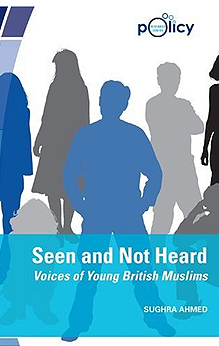
Author: Sughra Ahmed
Genre: Muslims
Publisher: Policy Research Centre; First edition
Release Date: 25 Aug 2009
Format: Paperback
Pages: 104
Source: No longer available on the website
The primary sources for this evidence-based policy paper were nine focus groups, conducted across the UK and comprising roughly equal numbers of young men and women, nine interviews with youth workers and other specialists, drawn from a variety of faith backgrounds and a roundtable discussion including academics. The empirical data was collected between October 2007 and August 2008.
The author notes that “it is not the intention of this report to provide conclusive findings which can then be used to generalise about British Muslims; rather the purpose is to map views and encourage a more open engagement with young Muslims that will allow scope for future research”. The report includes the results of a literature survey which cites over 50 publications providing material and insights on policies and studies affecting Muslim youth. It has other chapters on ‘Education’, ‘Identity, Belonging & Citizenship’, ‘Community Leadership’, ‘Media’, ‘Policing & Crime’.
Among the interesting findings emerging specifically from new data of this study is the streak of resilience amongst the ‘young bloods’. For example in response to media misrepresentation, one remarks, “all that stuff, it does not put me off, it motivates me to go out and be more involved, to make a difference”. There is also a sense of solidarity, experienced in settings such as prison life, where “in some parts of the country, a new inmate need not worry about his safety as he will come across many others from his area, community or town, and will have a support network should there be any bullying”. Young Muslim women in Brixton, “predominantly of an Afro-Caribbean background, felt they were amongst the more engaged members of their local societies”. Some of these interviewees were wearing the niqab which for some odd reason is referred to by the author as “plain back coverings, over their faces”. Thanks to Jack Straw, the word niqab has entered common parlance and it can be used directly.
The disappointment of this report is that it is not possible for a reader to join the dots between the empirical evidence collected and its recommendations. The citations from other research studies, surveys and published work that are interwoven with focus group quotes could have been placed in the literature survey chapter, leaving the study’s own findings to take centre stage.
This blurring makes it difficult to ground the Report’s bold policy prescriptions. For example, the point is made that “the Muslim communities of Britain have yet to create a sufficient quantity of leadership figures that are respected by grassroots Muslims and at the same time can deal effectively with the political challenges of the day”. It is not clear which focus group’s statements point to this contentious assessment. Opinion or grounded observation? Moreover, it believes that “a national Muslim heritage programme should be funded for collating the experiences of Muslim pioneers arriving post World War II and integrating into British life. The project would highlight lessons learnt from such experiences which can inform a sense of ‘Britishness’ for younger Muslims…..”. However the chapter on ‘Identity, Belonging & Citizenship’ offers few clues as to how this recommendation came about. What does come across from some focus group quotations is the ability of many to accommodate both their Britishness with a deep connection with the global ummah. Given the effort that the Islamic Foundation’s Policy Research Centre has invested in collecting empirical evidence, it would be welcome if the survey datasets would at some point be made publicly available in its archives in suitably anonymised form.
